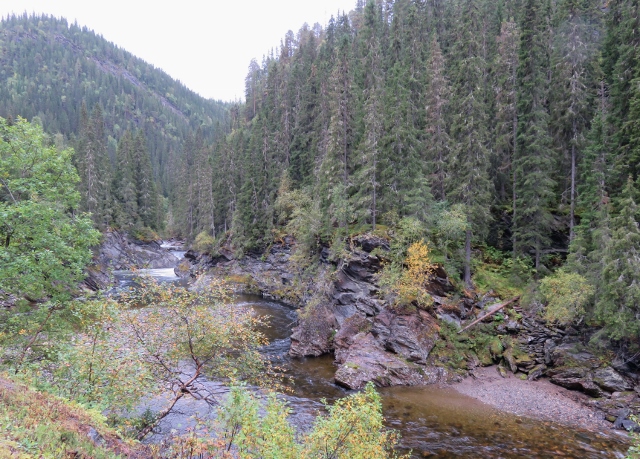The Route:
Midtre Gauldal Rest Area, Norway -- Roros, Norway -- Meteorite Crash Site, Funasdalen, Sweden -- Stockholm

19092015 - Both of us were too cold to move out from the car when we woke up. Prof Sweet Tooth started the car to get some warmth. I hurried to the toilet, forcing myself to face the cold. The Rest Area has one toilet for the man and woman, and it is so clean. There is no smell. And it is a spacious toilet.
The drive continues on. From the big Scandinavian map, Prof Sweet Tooth pointed out to Roros. It was the next big town along the route.


The view along the drive did not fail to impress me. I told Prof Sweet Tooth to drive slower for me to snap some photos. Gorgeous. Then, we saw the Eggafossen Waterfall. Immediately, Prof Sweet Tooth stopped at the designated parking spot because he, too was stunned by the beauty of it. I just had an orgasm looking at the waterfall. 'We have to go' I said. This time, Prof Sweet Tooth wore a yellow fluorescent vest where he explained that it is a requirement to wear this while walking on the road to ensure drivers can see you.
Gaula flows through the Gauldal valley in Sør-Trøndelag county, Norway. It is the biggest river in Central Norway. The Gaula River is approximately 145 kilometres (90 mi) long. Within the Gaula River, there are two well known waterfalls called Gaulfoss close to the village of Hovin and the Eggafoss near the village of Haltdalen. (Source from Wikipedia)






We reached Roros and the wind was strong. I was hating the weather. I was shivering so bad but I still wanted to take photos. I tried very much to ignore the piercing chill in my bones and appreciate the UNESCO Town of Roros.
Røros is a town and municipality in Sør-Trøndelag county, Norway. The mining town of Røros is sometimes called Bergstaden which means "the mining town" due to its historical notoriety for copper mining. It is one of two towns in Norway that were historically designated "mining towns", along with the "silver-town" of Kongsberg. The modern-day inhabitants of Røros still work and live in the characteristic 17th and 18th century buildings which have led to its designation as a UNESCO World Heritage Site in 1980. Røros has about 80 wooden houses, most of them standing around courtyards. Many retain their dark pitch-log facades, giving the town a medieval appearance. (Source from Wikipedia)






This is the mining facility in Roros. We walked inside the field area and I think I was going to have a frost bite walking up a small pile of earth, as the wind got stronger. But when I stood on top of the earth pile, I saw a colourful view in front of me. Yellow and green trees. Red and orange houses. Some of the houses have grass growing on the roof. I was so happy to see that! I could not resist the temptation to remove my gloves and brave the chill to take a panaromic photo.
Let's read a bit on grass roof in Norway. Source from EasyNorway.Wordpress.com
Keeps walls straight: The load of approximately 250 kg per m² of a grass roof is an advantage because it helps to compress the logs and make the walls more draught-proof. Therefore keeping straighter wooden walls which were prone to warp with changes in moisture in the wood. In winter, the total load may well increase to 400 or 500 kg per m² because of snow.
Good form of insulation: Grass roof is also a reasonably efficient insulator in a cold climate. The birch bark underneath ensures that the roof will be waterproof.












After Roros, we were on our way back to Sweden. And I got to see reindeers! I walked slowly to snap photos of them, and they could sense a human approaching, and were quick to run away.


We stopped at a meteorite crash site in Funasdalen. Specifically, road 84 between Funasdalen and Tannas, as dictated by Prof Sweet Tooth. It is a 44-metre diameter crater created 2000 years ago. The walk to the crater took less than 5 minutes. The crater site is very beautiful with flowers and plants growing around it.





More scenic view along the way back to Stockholm before we used the main road.




The road trip has come to an end. Mr Citroen C4 can finally rest after his 19 days of service to us. He has certainly served us well, and did not disappoint us during the entire trip. Warm. Comfortable. Sufficient space for two of us. He is just a car, as how Prof Sweet Tooth feared I put it. But Mr Citroen C4 has proven us more than just a car. He was the reason our road trip went so smoothly and he deserves a praise. Thank you, Mr Citroen C4 and his master, Prof Sweet Tooth for the long hours of driving. I have yet to meet anyone who could drive as long as you could.
A road trip worth spending on. The weather I braved. The places I saw. The food I tried.
Good memories.
1 comment:
It is so ironic that the the temperature now in the end of November was a Little bit warmer than we reached the northern part of Sweden and Norway in September...! Next time we will do the adventure a little bit more advanced, we should try to spend the night in one of those shelters in the nature with the Bonfire in front of the shelter. Let's hope it is a reindeer that wake one up by licking on ones face and not a scary bear... ;-)
Post a Comment